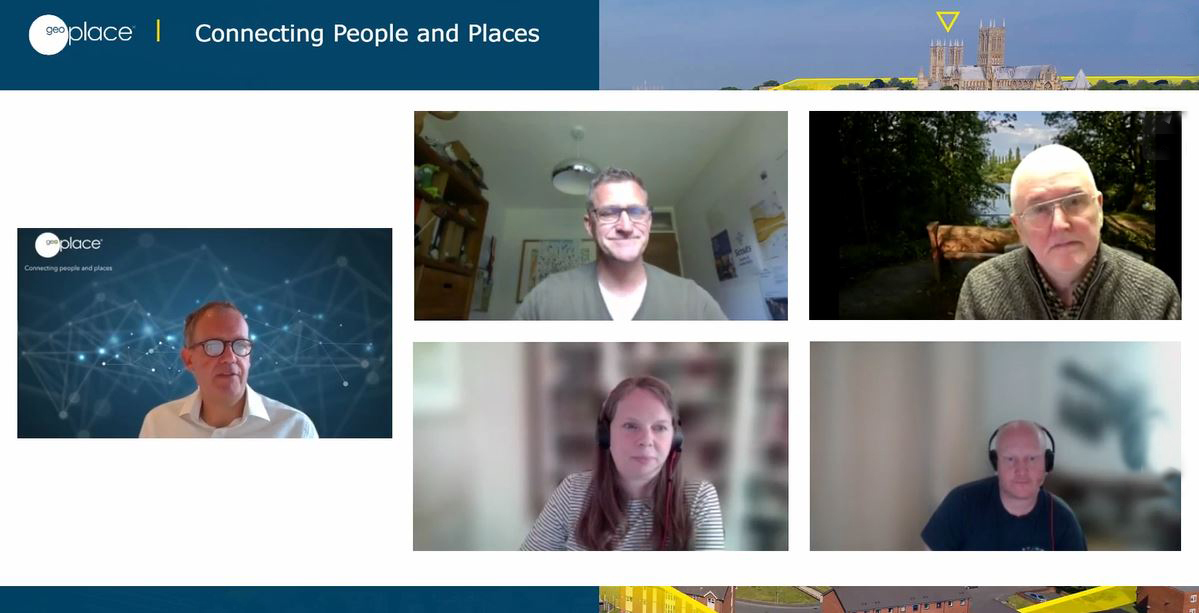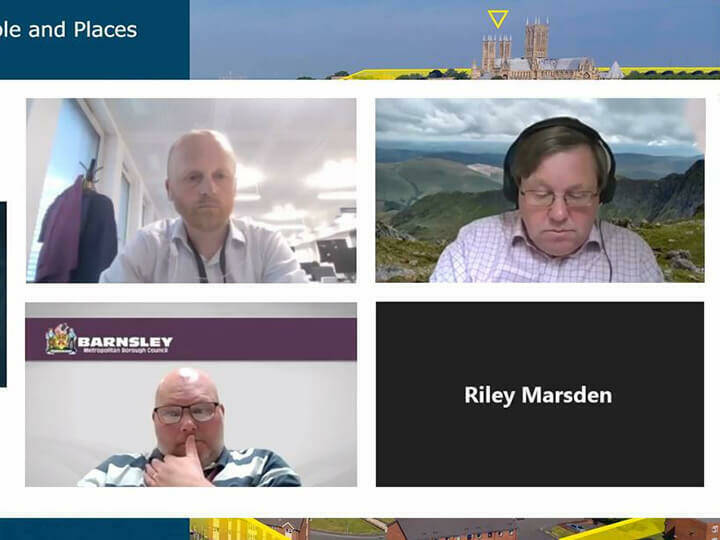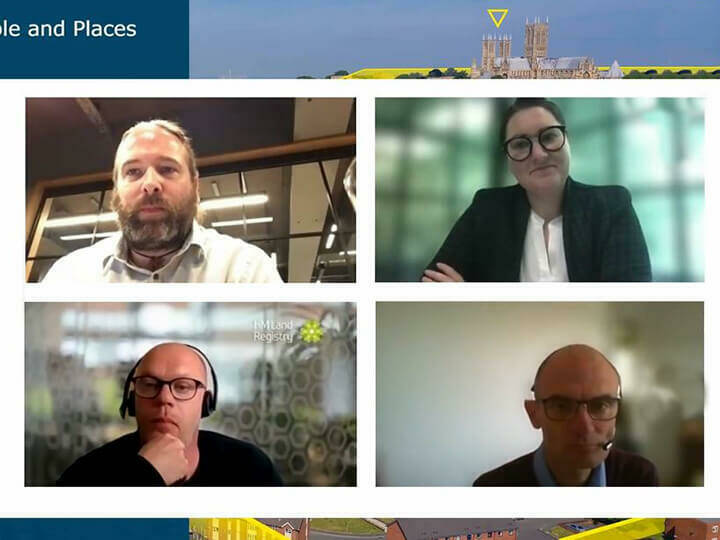At the 2022 GeoPlace conference, this session gave insights into the National Underground Asset Register, Project Gigabit (the network connections between people and premises), and Active Travel in Wales.
The speakers:
The National Underground Asset Register's position in the wider geospatial ecosystem
- Holger Kessler, NUAR Stakeholder and Communications Lead, Geospatial Commission
Understanding the network connections of people and premises through geospatial data and Linked Identifiers in Project Gigabit
- Chris Page, Place Based Strategies Leading on Data and Geospatial, Department of Culture, Media and Sport (DCMS)
Active travel supporting the cycling and walking infrastructure in Welsh communities
- Esme Farewell, Active Travel Policy Manager, Welsh Government
- Tom Colley, Lead Developer, Geography & Technology, Welsh Government

Holger Kessler, National Underground Asset Register (NUAR) Stakeholder and Communications Lead at the Geospatial Commission (GC), opened this session with an insight about the progress of the NUAR, and its position in the wider geospatial ecosystem.
The NUAR has evolved from Project Iceberg, a collaborative initiative that was explored by the British Geological Survey, Ordnance Survey, and Future Cities Catapult and has been built on the successful initiatives by Northumbrian Water Group and the OS in the North East of England and and Thames Water and TfL in London. Key stakeholders involved with the NUAR include Land Registry, Street Manager, Mapping GM, UKWIR, the National Energy System, and the Scottish Road Works Commissioner; Atkins; 1Spatial; OS; GLS; Open Geospatial Consortium; Transport Scotland and the HSE.
With data held by over 650 organisation, +++, there is a definitely a need for a NUAR. The NUAR is evolving as an interactive, digital map of pipes and cables that should revolutionise the way this infrastructure is installed, maintained, operated, and repaired. Data provided by 650+ asset owners is being standardised and held securely. Beneficiaries will be the asset owners themselves; planners; excavators; data managers; plant protection officers; and the general public and businesses of all kinds – but there is also a push from BEIS, and from the communications providers too, who want to make better use of underground potential to deliver more connectivity and a lower carbon economy.
The NUAR should be available for Wales, North East England and London by March 2023, and for Northern Ireland and the rest of England by September 2024. Over 250 asset owners in the three initial areas are engaged, and over 100 data exploration agreements have been signed to date – enabling the NUAR team to examine data without publishing it on the live platform. 20 data Distribution Agreements have been signed already, however, to enable data publication.
Holger concluded by encouraging delegates of the conference to take part in the NUAR consultation (which is now closed). The Geospatial Commission is looking at how the NUAR can deliver optimum benefits for society and the economy. Plans include access through a secure portal, and WFS and outbound APIs may be available in the future, but this is subject to review.
Chris Page is the Place Based Strategies Leading on Data and Geospatial, Department of Culture, Media and Sport (DCMS) opened the next presentation which looked at the network connections of people and premises through geospatial data and Linked Identifiers in Project Gigabit.
Building Digital UK (BDUK) originated in 2010, with the aim of giving hard-to-reach areas access to gigabit-capable networks. Through various initiatives, this is now a thriving market with many millions of pounds having already been invested. However, the focus is on connectivity for people – the aim is 100% gigabit coverage as soon as possible, at the time of the conference, coverage is at 67%. After 10 years of investment, 3% of the UK’s premises do not have superfast network access at all.
BDUK uses data from the Office of National Statistics, OS, and various suppliers to push the initiative forwards. It wants to target the most difficult to reach 20% of network users. This accessibility is impacted by factors such as roads, landscape, infrastructure, and lines of sight. Ordnance Survey’s data is key here, the linked identifiers – the UPRNs and USRNs – that identify roads and paths leading to properties. This doesn’t mean this is the optimum route, but it does enable in-depth analysis of open landscapes and built-up areas.
The data used by BDUK is aggregated before it is visualised, as there are a range of problems that cause commercial providers to make decisions that they will not deliver services to premises. Chris showed an interactive map that visualised detailed aspects of BDUK’s data insights’ work: the example showed which areas did not have superfast connectivity yet, and made it possible to overlay reasons why that might be the case, even though they are fibre-enabled.
It is essential to have this level of detailed analysis, to achieve the aspiration of 100% coverage for the UK. BDUK is looking at developing a network diffusion model, which will look at the way roads are connected – another factor that influences providers’ decision-making.
Esme Farewell, Active Travel Policy Manager, and Tom Colley, Lead Developer, Geography & Technology for the Welsh Government opened the next presentation, looking at ‘Active Travel’ – a tool that supports supporting the cycling and walking infrastructure in Welsh communities.
Active travel in Wales is defined as walking, wheeling and cycling for everyday, purposeful journeys – although this doesn’t exclude motorised aids for transport. This modal shift delivers benefit in terms of health, pollution, equality, fewer material resources and improvements to the wider economy. The aim is to help people replace car journeys as much as possible with more environmentally friendly and health-conscious forms of transport.
Research shows that many people will travel up to 2 miles by foot, and up to 5 miles by bicycle. The Welsh Government wants to make active travel journeys more attractive, linking up routes that make this modal shift possible. The Active Travel Act requires local authorities to provide networks of safe, first, cohesive, comfortable and attractive walking and cycling routes withing and connecting to key settlements across Wales within a 15 year times period.
This needs a mapping system that meets active travel standards. It needs to show existing routes, future routes, route information, related facilities, barriers, and destinations – key pieces of information not only for the public who will use the mapping, but also for authorities that will need to place high amounts of confidence in ongoing decisions about these routes.
Tom took up the thread, explaining that DataMapWales is a publishing platform for geospatial data. It is predominately for use by Public Sector Wales bodies and partners, but was designed to be easy to use for non-technical users. Standards based – OCF, GEL2 – it delivers sophisticated visualisations and analysis that protect data to official sensitive levels, and is bilingual at every level – including metadata. DataMapWales uses Government Gateway authentication, and uses resilient and scalable architecture.
The front end comprises a website, applications, a catalogue, and a map tool – data can be searched and then downloaded in various formats. Active Travel is the first app built using DataMapWales, with access to all of its datasets and functionality. The map tool delivers great functionality, including filtering; zooming to selected features; exporting layers; comparing data; and – crucially – allowing Active Travel users to edit information included in the map.
Active Travel routes are created in sections. Route editing is possible by copying one of more segments from the base survey layer, with layers created from the National Street Gazetteer, with survey information added by Sustrans – but this layer itself cannot be edited.
Active Travel has been running for about 15 months. Collaboration has enabled great input to the appearance and functionality of the final system, ensuring it is fully fit for purpose. It’s an excellent means for local authorities to understand what they are working on, what neighbouring authorities are doing to extend active travel measures across the country. Next steps for Active Travel include adding data from other sources (such as OS’s Paths Network) use in publication of approved routes and in public consultations, for improved network routing, and in the integration of this information with other key datasets. The data should be available by WFS download in the future.
Watch the recordings of this session on the Day 1 tab on the conference agenda



